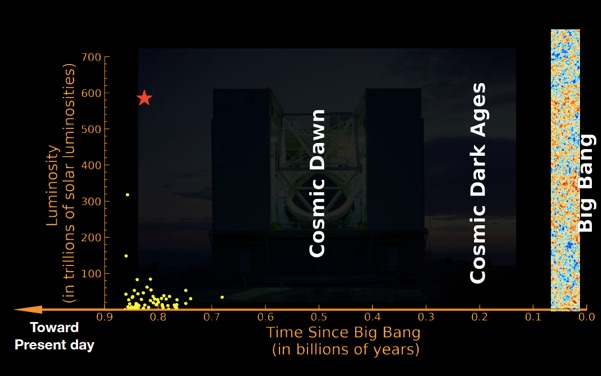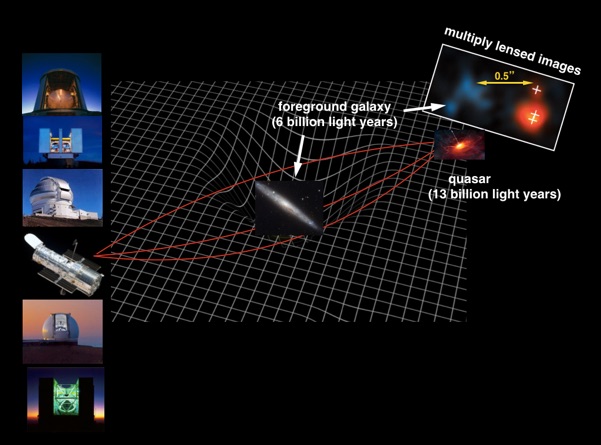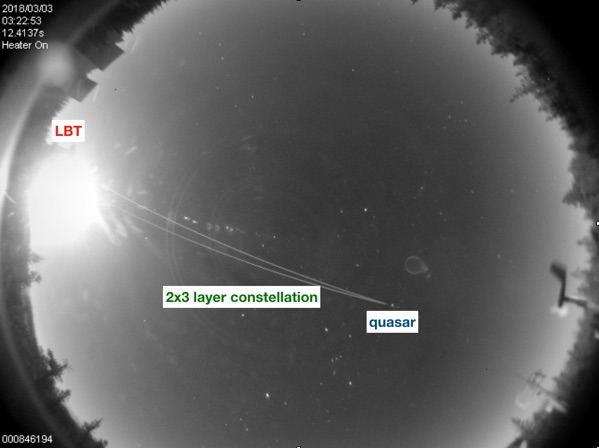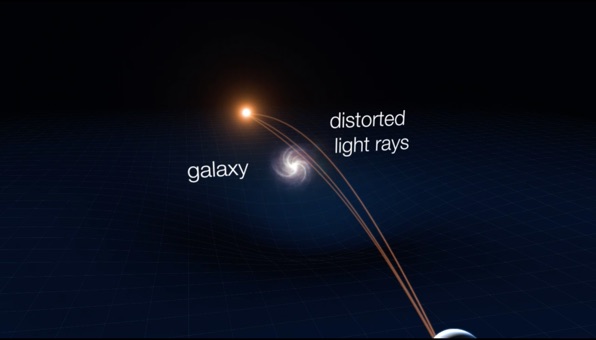Press Release Images of the Most Luminous Quasar in the Early Universe
This is a Hubble Space Telescope image of a very distant quasar (at right) that has been brightened and split into three images by the effects of the gravitational field of a foreground galaxy (left). The crosses mark the centers of each quasar image.
The quasar would have gone undetected if not for the power of gravitational lensing, which boosted its brightness by a factor of 50. The gravitational field of the foreground galaxy (seen at left) warps space like a funhouse mirror, amplifying the quasar’s light. Shining with the brilliance of 600 trillion suns, the quasar is fueled by a supermassive black hole at the heart of a young galaxy in the process of forming. The image shows the quasar as it looked 12.8 billion years ago – only about 1 billion years after the big bang.
The quasar appears red because its blue light has been absorbed by diffuse gas in intergalactic space. By comparison, the foreground galaxy has bluer starlight light.
The quasar, cataloged as J043947.08+163415.7 (J0439+1634 for short), could hold the record of being the brightest in the early universe for some time, making it a unique object for follow-up studies.
High resolution image can be found here.
Credit: NASA, ESA, Xiaohui Fan (University of Arizona)


Quasar J0439+1634 (red star) is the brightest quasar known in the early universe, with apparent luminosity of 600 trillion that of the sun. Such objects provide invaluable probes to the conditions of the universe less than one billion years after the Big Bang at Cosmic Dawn.
High resolution image can be found here.
And a version with the y-axis on log scale can be found here.
Credit: Feige Wang (UCSB), Xiaohui Fan (University of Arizona)

A number of large telescopes were used observe quasar J0439+1634 in the optical and infrared light. The 6.5m MMT Telescope was used to discovery this distant quasar. It and the 10m Keck-I Telescope obtained a sensitive spectrum of the quasar in optical light. The 8.2m Gemini Telescope obtained an infrared spectrum that accurately determined the quasar distance and the mass of its powerful black hole. The 2x8.4m Large Binocular Telescope captured an adaptive optics corrected image that suggests the quasar is lensed, later confirmed by the sharper Hubble image.
High resolution image can be found here.
Credit: Feige Wang (UCSB), Xiaohui Fan (University of Arizona)

The light from quasar J0439+1634, some 12.8 billion light years away, passes close to a faint galaxy that is about six billion light years away. The gravity of this foreground galaxy warps the space around it, according Einstein’s theory of general relativity. This bends the light like an optical lens, magnifies the quasar image by a factor of fifty, while at the same time split the quasar image into three. Both the foreground galaxy and the multiply imaged quasar is captured by the high resolution image of the Hubble SpaceTelescope.
High resolution image can be found here.
Credit: NASA, ESA, Xiaohui Fan (University of Arizona)

The light from quasar J0439+1634, some 12.8 billion light years away, passes close to a faint galaxy that is about six billion light years away. The gravity of this foreground galaxy warps the space around it, according Einstein’s theory of general relativity. This bends the light like an optical lens, magnifies the quasar image by a factor of fifty, while at the same time split the quasar image into three. Both the foreground galaxy and the multiply imaged quasar is captured by the high resolution image of the Hubble SpaceTelescope. Ground-based telescopes, including the MMT, Keck, Gemini, LBT and JCMT, are used to observe this object in optical, infrared and sub-millimeter wavelengths to measure its distance, and to characterize its central black hole and host galaxy.
High resolution version of the image can be found here.
Credit: NASA, ESA, Xiaohui Fan (University of Arizona)
Quasar J0439+1634 was observed with the Large Binocular Telescope on 3 March 2018. With the aid of its duel-beam laser system, LBT uses adaptive optics to overcome the blurring of the earth’s atmosphere, producing a sharp image that suggests J0493+1634 is lensed by a closely aligned foreground galaxy. The picture captures a sky camera view of Mt. Graham, with LBT’s lasers pointing to the constellation Taurus, where the quasar is located on the sky.
High resolution image can be found here.
Credit: LBT and Xiaohui Fan (University of Arizona)


This artist’s impression shows how J043947.08+163415.7, a very distant quasar powered by a supermassive black hole, may look close up. This object is by far the brightest quasar yet discovered in the early Universe.
High resolution image can be found here.
Credit:
ESA/Hubble, NASA, M. Kornmesser
This animation (link here) depicts how the mass of a galaxy is bending the light of a much more distant quasar through gravitational lensing. This way the quasar appear three times larger and 50 times brighter on the night sky.
Credit: Hubble/L. Calçada

